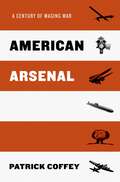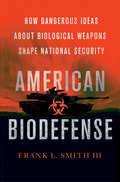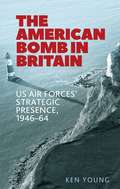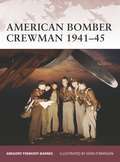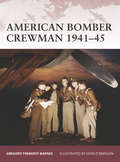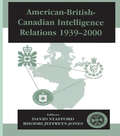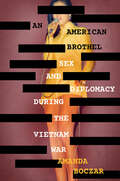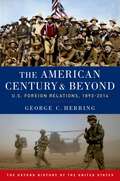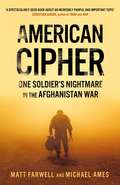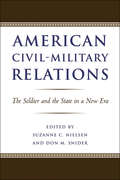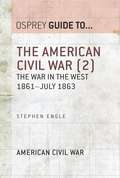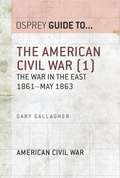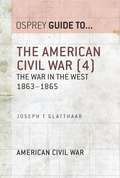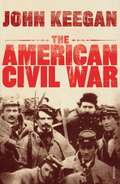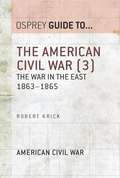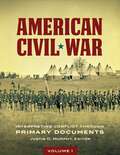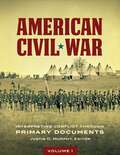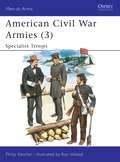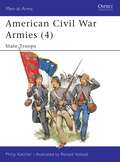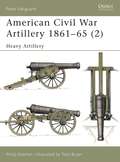- Table View
- List View
American Arsenal: A Century of Waging War
by Patrick CoffeyWhen America declared war on Germany in 1917, the United States had only 200,000 men under arms, a twentieth of the German army's strength, and its planes were no match for the German air force. Less than a century later, the United States today has by far the world's largest military budget and provides over 40% of the world's armaments. In American Arsenal Patrick Coffey examines America's military transformation from an isolationist state to a world superpower. Focusing on fifteen specific developments, Coffey illustrates the unplanned, often haphazard nature of this transformation, which has been driven by political, military, technological, and commercial interests. Beginning with Thomas Edison's work on submarine technology, American Arsenal moves from World War I to the present conflicts in the Middle East, covering topics from chemical weapons, strategic bombing, and the nuclear standoff with the Soviet Union, to "smart" bombs, hand-held anti-aircraft missiles, and the Predator and other drone aircrafts. Coffey traces the story of each advance in weaponry from drawing board to battlefield, and includes fascinating portraits of the men who invented and deployed them -Edward Teller, "the father of the hydrogen bomb", Robert Oppenheimer, head of atomic bomb design at Los Alamos; Curtis LeMay, who led the fire-bombing of Japan; Herman Kahn, nuclear strategist and a model for Stanley Kubrick's Dr. Strangelove; Abraham Karem, inventor of the Predator, and many others. Coffey also examines the increasingly detached nature of modern American warfare- the ultimate goal is to remove soldiers from the battlefield entirely- which limits casualties (211,454 in Vietnam and only 1,231 in the Gulf War) but also lessens the political and psychological costs of going to war. Examining the backstories of every major American weapons development, American Arsenal is essential reading for anyone interested in the continuing evolution of the U.S. defense program.
American Arsenal: A Century of Waging War
by Patrick CoffeyWhen America declared war on Germany in 1917, the United States had only 200,000 men under arms, a twentieth of the German army's strength, and its planes were no match for the German air force. Less than a century later, the United States today has by far the world's largest military budget and provides over 40% of the world's armaments. In American Arsenal Patrick Coffey examines America's military transformation from an isolationist state to a world superpower. Focusing on fifteen specific developments, Coffey illustrates the unplanned, often haphazard nature of this transformation, which has been driven by political, military, technological, and commercial interests. Beginning with Thomas Edison's work on submarine technology, American Arsenal moves from World War I to the present conflicts in the Middle East, covering topics from chemical weapons, strategic bombing, and the nuclear standoff with the Soviet Union, to "smart" bombs, hand-held anti-aircraft missiles, and the Predator and other drone aircrafts. Coffey traces the story of each advance in weaponry from drawing board to battlefield, and includes fascinating portraits of the men who invented and deployed them -Edward Teller, "the father of the hydrogen bomb", Robert Oppenheimer, head of atomic bomb design at Los Alamos; Curtis LeMay, who led the fire-bombing of Japan; Herman Kahn, nuclear strategist and a model for Stanley Kubrick's Dr. Strangelove; Abraham Karem, inventor of the Predator, and many others. Coffey also examines the increasingly detached nature of modern American warfare- the ultimate goal is to remove soldiers from the battlefield entirely- which limits casualties (211,454 in Vietnam and only 1,231 in the Gulf War) but also lessens the political and psychological costs of going to war. Examining the backstories of every major American weapons development, American Arsenal is essential reading for anyone interested in the continuing evolution of the U.S. defense program.
American Biodefense: How Dangerous Ideas about Biological Weapons Shape National Security (Cornell Studies in Security Affairs)
by Frank SmithBiological weapons have threatened U.S. national security since at least World War II. Historically, however, the U.S. military has neglected research, development, acquisition, and doctrine for biodefense. Following September 11 and the anthrax letters of 2001, the United States started spending billions of dollars per year on medical countermeasures and biological detection systems. But most of this funding now comes from the Department of Health and Human Services rather than the Department of Defense. Why has the U.S. military neglected biodefense and allowed civilian organizations to take the lead in defending the country against biological attacks? In American Biodefense, Frank L. Smith III addresses this puzzling and largely untold story about science, technology, and national security.Smith argues that organizational frames and stereotypes have caused both military neglect and the rise of civilian biodefense. In the armed services, influential ideas about kinetic warfare have undermined defense against biological warfare. The influence of these ideas on science and technology challenges the conventional wisdom that national security policy is driven by threats or bureaucratic interests. Given the ideas at work inside the U.S. military, Smith explains how the lessons learned from biodefense can help solve other important problems that range from radiation weapons to cyber attacks.
The American bomb in Britain: US Air Forces' strategic presence, 1946–64
by Ken YoungThis study tells the story of the strategic nuclear forces deployed to England by the United States from the late 1940s, and details the secret agreement made to launch atomic strikes against the USSR. Drawing on more than a decade's research in archives on both sides of the Atlantic, hitherto unknown aspects of Cold War history are revealed. The book deals with the United States Air Force's (USAF) relations with their British hosts as well as tensions between the American commands, with the continuous struggle to develop and safeguard the expanding base network and with the losing battle to provide the deployed bomber forces with an adequate air defence. This challenging analysis, based on massive archival sources, will provoke and stimulate Cold War historians and air power enthusiasts alike, and be read by those many veterans who served in the units of Strategic Air Command and the USAF in Europe, during that brief but dangerous period of nuclear history.
American Bomber Crewman 1941–45 (Warrior)
by Gregory Fremont-Barnes Seán Ó’BrógáinGregory Fremont-Barnes examines the lives of the American Bomber Crewmen of the Eighth Air Force, 'The Mighty Eighth', who manned, maintained and repaired the Boeing B-17 Flying Fortresses and the B-24 Liberators that flew from the airfields of England. He highlights the physical and psychological strain placed on these men, who required brute strength to control the aircraft on long bombing missions and extraordinary endurance to fly for hours at 20,000 feet at temperatures below freezing in unpressurised cabins. In addition to this, with Luftwaffe fighters and anti-aircraft fire to contend with, it required incredible skill and some luck to return from a mission unscathed. This book is a fitting tribute to these often uncelebrated heroes who took the war deep into the Third Reich, as well as a fascinating historical account of their experiences.
American Bomber Crewman 1941–45 (Warrior)
by Gregory Fremont-Barnes Seán Ó’BrógáinGregory Fremont-Barnes examines the lives of the American Bomber Crewmen of the Eighth Air Force, 'The Mighty Eighth', who manned, maintained and repaired the Boeing B-17 Flying Fortresses and the B-24 Liberators that flew from the airfields of England. He highlights the physical and psychological strain placed on these men, who required brute strength to control the aircraft on long bombing missions and extraordinary endurance to fly for hours at 20,000 feet at temperatures below freezing in unpressurised cabins. In addition to this, with Luftwaffe fighters and anti-aircraft fire to contend with, it required incredible skill and some luck to return from a mission unscathed. This book is a fitting tribute to these often uncelebrated heroes who took the war deep into the Third Reich, as well as a fascinating historical account of their experiences.
American-British-Canadian Intelligence Relations, 1939-2000 (Studies in Intelligence)
by Rhodri Jeffreys-Jones David StaffordThis work considers, for the first time, the intelligence relationship between three important North Atlantic powers in the Twenty-first century, from WWII to post-Cold War. As demonstrated in the case studies in this volume, World War II cemented loose and often informal inter-allied agreements on security intelligence that had preceded it, and created new and important areas of close and formal co-operation in such areas as codebreaking and foreign intelligence.
American-British-Canadian Intelligence Relations, 1939-2000 (Studies in Intelligence)
by David Stafford Rhodri Jeffreys-JonesThis work considers, for the first time, the intelligence relationship between three important North Atlantic powers in the Twenty-first century, from WWII to post-Cold War. As demonstrated in the case studies in this volume, World War II cemented loose and often informal inter-allied agreements on security intelligence that had preceded it, and created new and important areas of close and formal co-operation in such areas as codebreaking and foreign intelligence.
An American Brothel: Sex and Diplomacy during the Vietnam War (The United States in the World)
by Amanda BoczarIn An American Brothel, Amanda Boczar considers sexual encounters between American servicemen and civilians throughout the Vietnam War, and she places those fraught and sometimes violent meetings in the context of the US military and diplomatic campaigns.In 1966, US Senator J. William Fulbright declared that "Saigon has become an American brothel." Concerned that, as US military involvement in Vietnam increased so, too, had prostitution, black market economies, and a drug trade fueled by American dollars, Fulbright decried an arrogance of power on the part of Americans and the corrosive effects unchecked immorality could have on Vietnam as well as on the war effort. The symbol, at home and abroad, of the sweeping social and cultural changes was often the so-called South Vietnamese bar girl.As the war progressed, peaking in 1968 with more than half a million troops engaged, the behavior of soldiers off the battlefield started to impact affect the conflict more broadly. Beyond the brothel, shocking revelations of rapes and the increase in marriage applications complicated how the South Vietnamese and American allies cooperated and managed social behavior. Strictures on how soldiers conducted themselves during rest and relaxation time away from battle further eroded morale of disaffected servicemen. The South Vietnamese were loath to loosen moral restrictions and feared deleterious influence of a permissive wWestern culture on their society.From the consensual to the coerced, sexual encounters shaped the Vietnam War. Boczar shows that these encounters—sometimes facilitated and sometimes banned by the US military command—restructured the South Vietnamese economy, captivated international attention, dictated military policies, and hung over diplomatic relations during and after the war.
The American Century and Beyond: U.S. Foreign Relations, 1893-2014 (Oxford History of the United States)
by George C. HerringIn his last years as president of the United States, an embattled George Washington yearned for a time when his nation would have "the strength of a Giant and there will be none who can make us afraid." At the turn of the twentieth century, the United States seemed poised to achieve a position of world power beyond what even Washington could have imagined. In The American Century and Beyond: U.S. Foreign Relations, 1893-2014, the second volume of a new split paperback edition of the award-winning From Colony to Superpower, George C. Herring recounts the rise of the United States from the dawn of what came to be known as the American Century. This fast-paced narrative tells a story of stunning successes and tragic failures, illuminating the central importance of foreign relations to the existence and survival of the nation. Herring shows how policymakers defined American interests broadly to include territorial expansion, access to growing markets, and the spread of the "American way of life." He recounts the United States' domination of the Caribbean and Pacific, its decisive involvement in two world wars, and the eventual victory in the half-century Cold War that left it, after the collapse of the Soviet Union, the world's lone superpower. But the unipolar moment turned out to be stunningly brief. Since the turn of the twenty-first century, conflicts in Afghanistan and Iraq and the emergence of nations such as Brazil, Russia, India, and China have left the United States in a position that is uncertain at best. A new chapter brings Herring's sweeping narrative up through the Global War on Terror to the present.
The American Century and Beyond: U.S. Foreign Relations, 1893-2014 (Oxford History of the United States)
by George C. HerringIn his last years as president of the United States, an embattled George Washington yearned for a time when his nation would have "the strength of a Giant and there will be none who can make us afraid." At the turn of the twentieth century, the United States seemed poised to achieve a position of world power beyond what even Washington could have imagined. In The American Century and Beyond: U.S. Foreign Relations, 1893-2014, the second volume of a new split paperback edition of the award-winning From Colony to Superpower, George C. Herring recounts the rise of the United States from the dawn of what came to be known as the American Century. This fast-paced narrative tells a story of stunning successes and tragic failures, illuminating the central importance of foreign relations to the existence and survival of the nation. Herring shows how policymakers defined American interests broadly to include territorial expansion, access to growing markets, and the spread of the "American way of life." He recounts the United States' domination of the Caribbean and Pacific, its decisive involvement in two world wars, and the eventual victory in the half-century Cold War that left it, after the collapse of the Soviet Union, the world's lone superpower. But the unipolar moment turned out to be stunningly brief. Since the turn of the twenty-first century, conflicts in Afghanistan and Iraq and the emergence of nations such as Brazil, Russia, India, and China have left the United States in a position that is uncertain at best. A new chapter brings Herring's sweeping narrative up through the Global War on Terror to the present.
American Cipher: One Soldier’s Nightmare in the Afghanistan War
by Matt Farwell Michael AmesThe explosive narrative of the life, captivity, and trial of Bowe Bergdahl, the soldier who was abducted by the Taliban and whose story has served as a symbol for America's foundering war in AfghanistanIn the early hours of June 30, 2009, Private First Class Bowe Bergdahl walked off his platoon's base. Since that day, easy answers to the many questions surrounding his case have proved elusive. Why did he leave his post? What kinds of efforts were made to recover him from the Taliban? And why, facing court martial, did he plead guilty to the serious charges against him?In American Cipher, journalists Matt Farwell and Michael Ames persuasively argue that the Bergdahl story is as illuminating an episode as we have as we seek the larger truths of how the United States lost its way in Afghanistan. Telling the parallel stories of an idealistic, misguided young soldier and a nation stalled in an unwinnable war, the book reveals the fallout that ensued when the two collided, and in the process, provides a definitive corrective to the composite of narratives - many simplistic or flawed, unfair or untrue - that have contributed to the Bergdahl myth. Based on years of exclusive reporting drawing on dozens of sources throughout the military, government, and Bergdahl's family, friends, and fellow soldiers, American Cipher is at once a meticulous investigation of government dysfunction and political posturing, a blistering commentary on America's presence in Afghanistan, and a heart-breaking chronicle of a naive young man who thought he could fix the world and wound up as the tool of forces far beyond his understanding.
American Civil-Military Relations: The Soldier and the State in a New Era
by Suzanne C. Nielsen Don M. SniderAmerican Civil-Military Relations offers the first comprehensive assessment of the subject since the publication of Samuel P. Huntington's field-defining book, The Soldier and the State. Using this seminal work as a point of departure, experts in the fields of political science, history, and sociology ask what has been learned and what more needs to be investigated in the relationship between civilian and military sectors in the 21st century.Leading scholars—such as Richard Betts, Risa Brooks, James Burk, Michael Desch, Peter Feaver, Richard Kohn, Williamson Murray, and David Segal—discuss key issues, including:• changes in officer education since the end of the Cold War;• shifting conceptions of military expertise in response to evolving operational and strategic requirements;• increased military involvement in high-level politics; and• the domestic and international contexts of U.S. civil-military relations.The first section of the book provides contrasting perspectives of American civil-military relations within the last five decades. The next section addresses Huntington's conception of societal and functional imperatives and their influence on the civil-military relationship. Following sections examine relationships between military and civilian leaders and describe the norms and practices that should guide those interactions. The editors frame these original essays with introductory and concluding chapters that synthesize the key arguments of the book. What is clear from the essays in this volume is that the line between civil and military expertise and responsibility is not that sharply drawn, and perhaps given the increasing complexity of international security issues, it should not be. When forming national security policy, the editors conclude, civilian and military leaders need to maintain a respectful and engaged dialogue. American Civil-Military Relations is essential reading for students and scholars interested in civil-military relations, U.S. politics, and national security policy.
The American Civil War: The war in the West 1861–July 1863 (Guide to...)
by Stephen EngleThe American Civil War's vast Western Theater witnessed enormously important military campaigning during the period 1861 - 1863. This book, the third in a four-volume series, examines the geographical, logistical and strategic factors that shaped fighting in this theater, as well as assessing officers who played key roles . It covers the story of Ulysses S Grant's important capture of rebel positions before marching south to win the battle of Shiloh, as well as that of Albert Sidney Johnston, the pride of the Confederacy. Finally, it details the dramatic events of the siege of Vicksburg, the Confederates final fortress.
The American Civil War: The war in the East 1861–May 1863 (Guide to... #4)
by Gary GallagherThe United States saw long-simmering sectional tensions erupt into fighting at Fort Sumter, South Carolina, in April 1861, beginning what would become the most cataclysmic military struggle in the western world between Waterloo and the First World War. This volume focuses on events in the Virginia theater during the conflict's first two years, highlighting Union and Confederate strengths and weaknesses, leadership and strategy on each side, and the ways in which events on the battlefield influenced politics, diplomacy, and debates about emancipation. Osprey Essential Histories are complete yet concise studies of each major conflict in history.
The American Civil War: The war in the West 1863–1865 (Guide to...)
by Joseph T. GlatthaarUnion military forces suffered momentary defeat followed by sustained success in the Western Theater during the second half of the American Civil War. Following the Union's defeat at Chickamauga, Ulysses S. Grant took command at Chattanooga and orchestrated a striking victory which paved the way for a Union advance against Atlanta, a confederate city second in importance only to Richmond. This book traces the events that surrounded the capture of Atlanta, followed by Sherman's famous campaign of destruction through the southern interior which culminated in April 1865 with the surrender of the last major Confederate field army at Durham Station, North Carolina.
The American Civil War: A Military History (Vintage Civil War Library)
by John KeeganThe American Civil War was one of the longest and bloodiest of modern wars. It is also one of the most mysterious. It has captured the imagination of writers, artists and film-makers for decades but the reality of it confuses and divides historians even today. In this magisterial history of the first modern war, the distinguished military historian John Keegan unpicks the geography, leadership and strategic logic of the war and takes us to the heart of the conflict. His captivating work promises to be the definitive history of the American Civil War.
The American Civil War: The war in the East 1863–1865 (Guide to...)
by Robert KrickGreat battles and famous commanders dominated the military history of the Civil War in the Eastern Theater during the period 1863-1865. This book includes revealing details of the clash at Gettysburg, Pennsylvania, the costliest battle ever waged in the Western Hemisphere, but, contrary to common belief, puts forward the theory that it was not a great turning point in the war. This book also examines the events that led to Robert E Lee accepting generous terms of surrender from Ulysses S Grant, bringing the war in Virginia to a close. A fascinating look at this crucial point in the American Civil War.
American Civil War [2 volumes]: Interpreting Conflict through Primary Documents [2 volumes]
by Justin D. MurphyBy providing detailed analyses of Civil War primary sources, this book will help readers to understand the history of the bloodiest of all American conflicts.This meticulously curated collection of primary source documents covers every aspect of the American Civil War, from its origins to its bloody engagements, all the way through the Reconstruction period. With approximately 300 primary sources, this comprehensive set includes orders and reports of significant battles, political debates and speeches, legislation, court cases, and literary works from the Civil War era. The documents provide insight into the thinking of all participants, drawing upon a vast range of sources that offer both a Northern and Southern perspective.The book gives equal treatment to the Eastern and Western Theaters and to Union and Confederate sources, and the primary sources are presented in chronological order, making it easy for readers to compare and contrast documents as the key events of the conflict unfold. Each primary source begins with an introduction that sets the document in its proper context and concludes with an analysis of the document that will help students to understand the document's significance.
American Civil War [2 volumes]: Interpreting Conflict through Primary Documents [2 volumes]
By providing detailed analyses of Civil War primary sources, this book will help readers to understand the history of the bloodiest of all American conflicts.This meticulously curated collection of primary source documents covers every aspect of the American Civil War, from its origins to its bloody engagements, all the way through the Reconstruction period. With approximately 300 primary sources, this comprehensive set includes orders and reports of significant battles, political debates and speeches, legislation, court cases, and literary works from the Civil War era. The documents provide insight into the thinking of all participants, drawing upon a vast range of sources that offer both a Northern and Southern perspective.The book gives equal treatment to the Eastern and Western Theaters and to Union and Confederate sources, and the primary sources are presented in chronological order, making it easy for readers to compare and contrast documents as the key events of the conflict unfold. Each primary source begins with an introduction that sets the document in its proper context and concludes with an analysis of the document that will help students to understand the document's significance.
American Civil War Armies: Specialist Troops (Men-at-Arms)
by Ronald Volstad Philip KatcherAt the time of the American Civil War, with two million men under arms, a US Army that in pre-war days had depended upon a minute number of technical troops now required virtually an army of specialists alone. Special sharpshooters were recruited for skirmishing duty; men whose wounds would have led to their discharge in the past now found themselves guarding important posts in the Veteran Reserve Corps; and large numbers of civilians found themselves in uniform as members of the Telegraph or Hospital Corps. Philip Katcher examines the organization and uniforms of the specialist troops who served in the armies of both sides.
American Civil War Armies: State Troops (Men-at-Arms)
by Ronald Volstad Philip KatcherThe War between the States' is the term used for the American Civil War throughout much of the South even today. Many on both sides – not just the South – felt that they were serving their states as much, if not more, than their central governments. Many of the states agreed; the state governments raising their own units, commissioning their officers, and supplying their men. Indeed, many of the units that fought the Civil War were supplied in large part by their own states rather than by the central government's quartermasters. Philip Katcher's fascinating text explores the uniforms of 32 states; from Alabama to Wisconsin.
American Civil War Armies: State Troops (Men-at-Arms #190)
by Ronald Volstad Philip KatcherThe War between the States' is the term used for the American Civil War throughout much of the South even today. Many on both sides – not just the South – felt that they were serving their states as much, if not more, than their central governments. Many of the states agreed; the state governments raising their own units, commissioning their officers, and supplying their men. Indeed, many of the units that fought the Civil War were supplied in large part by their own states rather than by the central government's quartermasters. Philip Katcher's fascinating text explores the uniforms of 32 states; from Alabama to Wisconsin.
American Civil War Armies: Specialist Troops (Men-at-Arms)
by Ronald Volstad Philip KatcherAt the time of the American Civil War, with two million men under arms, a US Army that in pre-war days had depended upon a minute number of technical troops now required virtually an army of specialists alone. Special sharpshooters were recruited for skirmishing duty; men whose wounds would have led to their discharge in the past now found themselves guarding important posts in the Veteran Reserve Corps; and large numbers of civilians found themselves in uniform as members of the Telegraph or Hospital Corps. Philip Katcher examines the organization and uniforms of the specialist troops who served in the armies of both sides.
American Civil War Artillery 1861–65: Heavy Artillery (New Vanguard)
by Tony Bryan Philip KatcherBecause of the length of the coastline of the United States, from the beginning American ordnance and engineers placed an emphasis on heavy artillery mounted in coastal defences. The Union army organised its 'Heavy Artillery' into separate regiments, uniformed and equipped differently. While the Field Artillery was assigned across the fighting fronts Heavy Artillery units served the big guns in the forts and the defences of Washington. The Confederates did not differentiate types of artillery and those that became known as Heavy Artillery did so through informal association rather than formal designation. This book details the development and usage of the big guns. New Vanguard 38 and 40 are also available in a single volume special edition as 'American Civil War Artillery 1861-65'.
